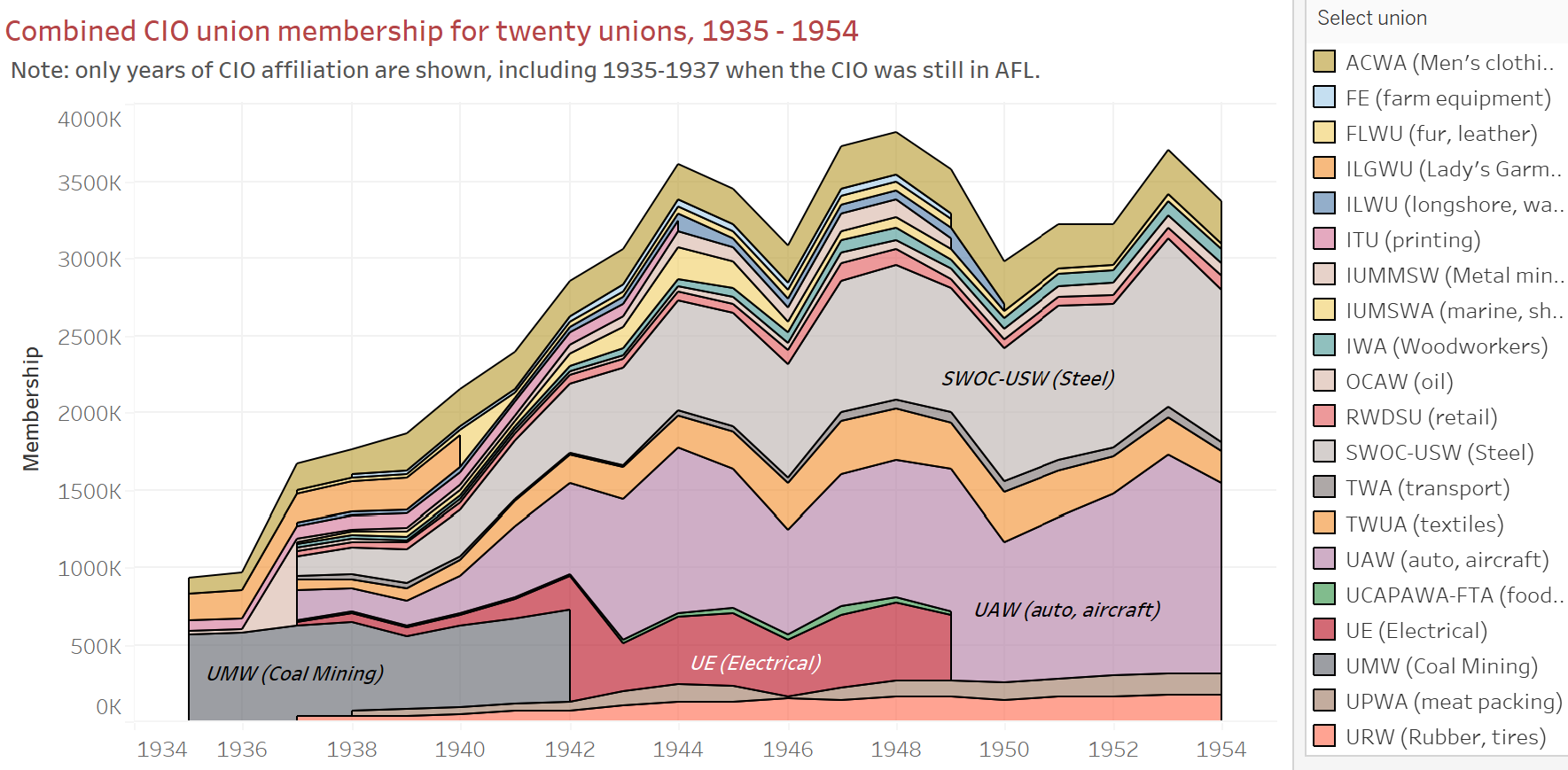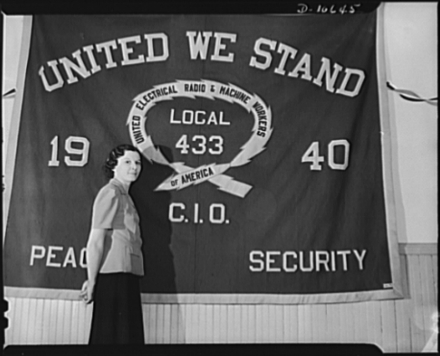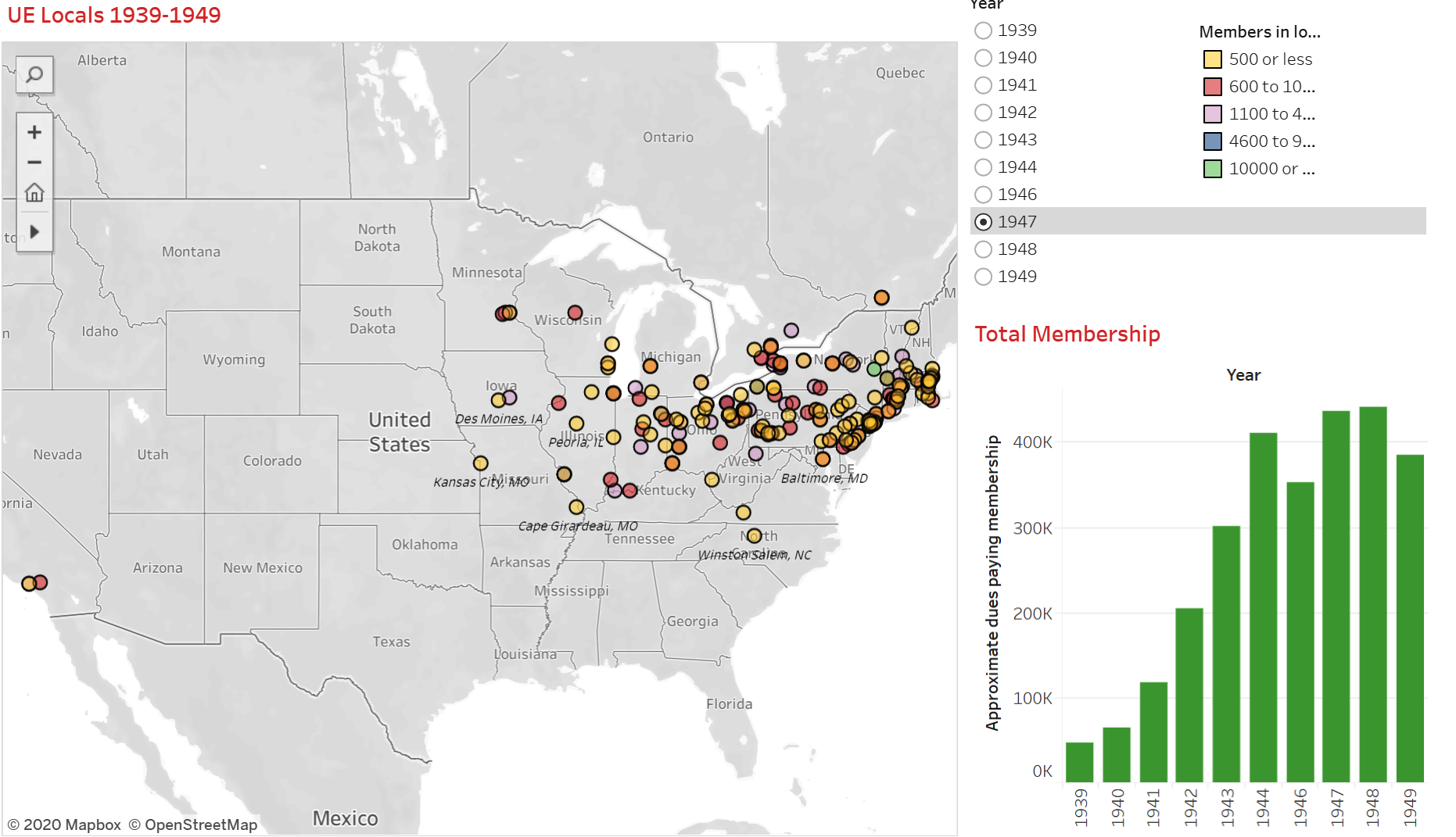CIO unions - Mapping locals and membership 1938-1949
 See larger interactive version below
See larger interactive version below
The Committee for Industrial Organization was launched in 1935 by leaders of the United Mine Workers and several other AFL unions that embraced industrial union organizing strategies. The goal was to build unions in core industries like steel, auto, aircraft, electrical appliances, meat packing, tires, and textiles that had blocked organizing efforts at every turn. Expelled from the AFL two years later, the CIO changed its name to the Congress of Industrial Organizations and began a contentious rivalry with the AFL that lasted until 1954 when the two federations reunited as the AFL-CIO. Here we explore the growth of the CIO using membership data.
The graphs at right (and second tab below) show annual membership numbers for twenty important CIO unions. The maps below are based on different records revealing year-by-year locations and membership numbers for local affiliates of seven unions. Follow the links to see detailed explorations of the geographic history of each of them. Here we combine membership numbers to show CIO density and the spread of locals across hundreds of cities. This is incomplete. We do not yet have geographic data for all affiliates. But shown in detail are some of the most important: United Auto Workers (UAW), United Electrical Workers (UE),Amalgamated Clothing Workers (ACWA), International Longshore and Warehouse Union (ILWU), and International Woodworkers of America (IWA). Also two that helped launch the CIO but later rejoined the AFL: International Ladies Garment Workers (ILGWU) which left the CIO in 1939, and International Typographical Union (ITU) which left in 1944. There is much more information on the separate map pages for each of the seven unions. Use the links above.
The maps are hosted by Tableau Public and may take a few seconds to respond. If slow, refresh the page.
Move between four maps and charts using the tabs below
Sources: Data for the annual international membership chart are taken from Leo Troy’s Trade Union Membership, 1897-1962 (New York: National Bureau of Economic Research, 1965). See the individual pages for the seven unions that are mapped.
Research and data compilation: Cameron Molyneux
Maps and charts: James Gregory
Additional CIO maps and charts
|
|
The CIO transformed American labor and American politics. Defying the American Federation of Labor's commitment to craft unionism, the Committee for Industrial Organization was launched in 1935 by leaders of the United Mine Workers and other AFL unions that had previously embraced industrial union organizing strategies. The goal was to build unions in core industries like steel, auto, aircraft, electrical appliances, meat packing, tires, and textiles that had blocked organizing efforts at every turn.
Here we explore the history and geography of the CIO unions from 1935 through the end of the 1940s with maps and membership data showing the growth and in some cases decline of what will be a growing list of the major unions starting with United Auto Workers (UAW), United Electrical Workers (UE), International Ladies Garment Workers (ILGWU), International Longshore and Warehouse Union (ILWU). |
|
Founded in 1935 as one of the first initiatives of the industrial union organizing committee led by John L. Lewis, the United Autoworkers won a breakthrough victory against General Motors in the dramatic Flint Michigan sit down strike in the winter of 1936-1937. After General Motors agreed to bargain, Chrysler and several smaller auto companies followed suit and by mid-1937 new union claimed 150,000 members and was spreading through the auto and parts manufacturing towns of Michigan, Ohio, Indiana, and Illinois. These maps chart the spread of the UAW from April 1939 when it counted 172 locals and about 170,000 members to 1944 with 634 locals and more than one million members then though the late 1940s when conversion to civilian production and a post-war recession caused a dip in membership even as the number of locals increased. Watch the UAW spread across the map in the 1940s, anchored in Michigan and the Great Lakes states but claiming dozens of locals in the Northeast and California, and a sprinkling in Alabama, Geogia, and Texas. |
|
Founded in 1936 by workers from General Electric, Westinghouse, Philco, RCA and other companies that made electrical appliances and machinery, UE soon became one of the largest and most controversial unions in the CIO, claiming a peak membership of 686,000 in 1944. UE was known as a left-wing union, many of its top leaders closely associated with the Communist Party. This had various implications in the early years. The union took strong positions on racial and gender equality. Women were important part of the work force and by the end of the war comprised about 40% of the membership. At the same time, the leftwing reputation left the union vulnerable to red-baiting, which nearly destroyed the union in the early 1950s. Here are five interactive maps and charts showing the year by year geography of the UE. |
Founded in 1900 in four East Coast cities by a workforce largely comprised of immigrants who had prior trade union experience in Europe, the ILGWU was one of the first female majority unions in the American Federation of Labor. As one of the AFL’s few industrial unions, the ILGWU joined the Committee for Industrial Organizing in 1935 as a founding member. But opposed to what they saw as rising communist influence in the CIO, ILGWU leaders left and reaffiliated with the AFL in 1940. Already well-established before joining the CIO, the ILGWU did not experience the same explosion in membership that new unions like the UAW and UE experienced in the later 1930s and 1940s. Despite this, the union maintained steady growth after 1935 and peaked at around 380,000 members in 1947. |
The ILWU broke away from the International Longshoreman's Association (ILA) in 1937 in order to join the CIO. The West Coast locals of the ILA had waged a three-month long strike in 1934, closing all the ports up and down the Pacific Coast and winning employer recognition for locals that had been without bargaining rights since the 1920s. Led by militants who defied orders from ILA headquarters, the 1934 victory had set the stage for the 1937 split. Over the next 12 years, the newly independent ILWU would solidify longshore locals along the entirety of the West Coast while starting successful organizing drives in farming in Hawaii and warehouse locals both on the West coast and states further east. During this period, the union’s membership more than doubled, from 25,000 to 65,000 dues paying members. |

 See larger interactive version below
See larger interactive version below 



